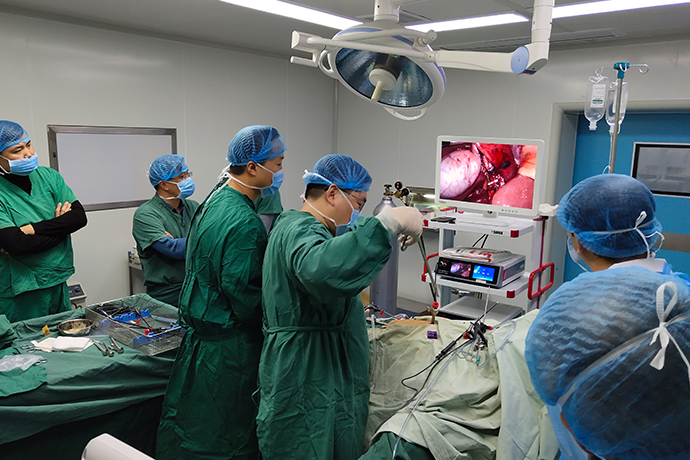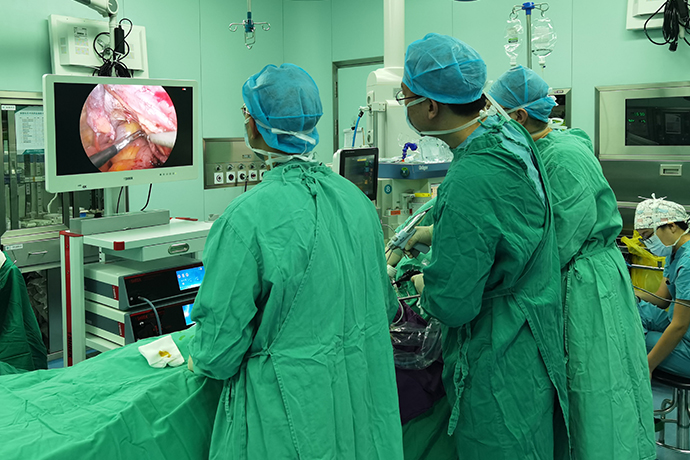[General Surgery Laparoscopy] 4K Ultra HD Laparoscopic Pancreaticojejunostomy
Release time: 08 May 2025 Author:Shrek
Pancreaticojejunostomy is an important part of pancreaticoduodenectomy. It is used to connect the remaining pancreas to the jejunum after the pancreas is removed to restore the drainage and digestive function of pancreatic juice. Laparoscopic pancreaticojejunostomy is performed using laparoscopic technology. Compared with traditional open surgery, it has the advantages of less trauma, faster recovery, and fewer complications.

Assume that the position about 5 cm away from the stump of the jejunum is the intended anastomosis site, and use an electric knife to mark the upper edge of the pancreas, the lower edge of the pancreas, and the intended anastomosis site of the pancreatic duct. Cut a little bit of the serosal layer, gently pull out the mucosa and cut it. During the anastomosis operation, the jejunal aperture will expand, so it must not be too large. Insert a bamboo-like pancreatic duct duct (with an enlarged nodule in the middle) from the stump of the jejunum, and lead it out from the hole for later use. Peel off at least 1 cm behind the stump of the pancreas. Slightly straighten the 4-0 Prolene SH-1 needle (diameter 26 mm) into a J shape. Suture from the ventral side of the pancreas to the dorsal side, and then suture the serosal layer of the jejunum from deep to shallow. The margin of the pancreatic side suture is about 1 cm (equivalent to the thickness of the pancreas).It is important to completely cover the pancreatic stump with the jejunum, so the width of the suture on the jejunal side should be more than 1.5 times the thickness of the pancreas or a small half of the jejunal wall. First, insert the needle close to the upper and lower edges of the main pancreatic duct while the pancreatic duct catheter is inserted, and then remove the pancreatic duct catheter to confirm that the pancreatic duct catheter is not sutured, otherwise remove it and suture it again. It should be noted that the upper and lower edges of the pancreatic stump are easily not covered by the intestinal wall and exposed to the outside. Sometimes there will be bleeding from the needle hole, which can be stopped by compression. In the Kakita anastomosis, the interval between the threads is 7mm, and most of the time 4 to 6 threads are used, but if the pancreatic stump can be completely covered, it is better to use fewer stitches. At the end of the suture, put the threads on the left and right respectively.
Pancreaticojejunostomy with film
A 5-0PDSIITF needle (12mm diameter single needle) is used for anastomosis, and Machiaran forceps used for cardiac surgery are used as forceps. Generally, 8 stitches are used for full-thickness suture. The pancreatic duct side should be sutured together with the surrounding pancreatic parenchyma, and the jejunal side should be sutured together with the mucosa under direct vision. First, a traction line is hung from the outside to the inside in the center of the anterior wall of the pancreatic duct and then pulled apart, so that the pancreatic duct is easier to see. Then suture the upper and lower ends of the pancreatic duct, and then sew 3 stitches on the posterior wall in the order of inside and outside and then outside and inside.Ligate the sutures of the posterior wall one by one, using moderate force to prevent excessive force from causing pancreatic parenchyma tearing. After the posterior wall is ligated, insert the pancreatic duct catheter and fix it with the suture in the center of the posterior wall. When suturing the anterior wall, it is much easier to use the backhand needle and start from the jejunal side in the order of outside-inside-outside. Suture the jejunal wall only in the center of the anterior wall with the previously indwelling traction line in the order from inside to outside. After suturing the anterior wall for 3 stitches, ligate it one by one.
Ligation after Kakita suture
When ligating sequentially, have the assistant pinch the intestinal wall to cover the pancreatic stump. Be careful to be gentle. The tightness of the ligature should be such that a thin-bladed scissors can be inserted between the pancreas and intestine.

- Recommended news
- 【General Surgery Laparoscopy】Cholecystectomy
- Surgery Steps of Hysteroscopy for Intrauterine Adhesion
- [Gynecological Hysteroscopy] Techniques for Preventing and Treating Complications of Hysteroscopic Surgery
- [Gynecological Hysteroscopy] Hysteroscopic Adhesiolysis
- [Gynecological Hysteroscopy] IUD Removal under Hysteroscopy